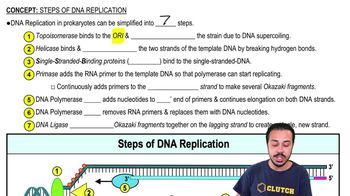Table of contents
- 1. Introduction to Biology2h 42m
- 2. Chemistry3h 40m
- 3. Water1h 26m
- 4. Biomolecules2h 23m
- 5. Cell Components2h 26m
- 6. The Membrane2h 31m
- 7. Energy and Metabolism2h 0m
- 8. Respiration2h 40m
- 9. Photosynthesis2h 49m
- 10. Cell Signaling59m
- 11. Cell Division2h 47m
- 12. Meiosis2h 0m
- 13. Mendelian Genetics4h 44m
- Introduction to Mendel's Experiments7m
- Genotype vs. Phenotype17m
- Punnett Squares13m
- Mendel's Experiments26m
- Mendel's Laws18m
- Monohybrid Crosses19m
- Test Crosses14m
- Dihybrid Crosses20m
- Punnett Square Probability26m
- Incomplete Dominance vs. Codominance20m
- Epistasis7m
- Non-Mendelian Genetics12m
- Pedigrees6m
- Autosomal Inheritance21m
- Sex-Linked Inheritance43m
- X-Inactivation9m
- 14. DNA Synthesis2h 27m
- 15. Gene Expression3h 20m
- 16. Regulation of Expression3h 31m
- Introduction to Regulation of Gene Expression13m
- Prokaryotic Gene Regulation via Operons27m
- The Lac Operon21m
- Glucose's Impact on Lac Operon25m
- The Trp Operon20m
- Review of the Lac Operon & Trp Operon11m
- Introduction to Eukaryotic Gene Regulation9m
- Eukaryotic Chromatin Modifications16m
- Eukaryotic Transcriptional Control22m
- Eukaryotic Post-Transcriptional Regulation28m
- Eukaryotic Post-Translational Regulation13m
- 17. Viruses37m
- 18. Biotechnology2h 58m
- 19. Genomics17m
- 20. Development1h 5m
- 21. Evolution3h 1m
- 22. Evolution of Populations3h 52m
- 23. Speciation1h 37m
- 24. History of Life on Earth2h 6m
- 25. Phylogeny2h 31m
- 26. Prokaryotes4h 59m
- 27. Protists1h 12m
- 28. Plants1h 22m
- 29. Fungi36m
- 30. Overview of Animals34m
- 31. Invertebrates1h 2m
- 32. Vertebrates50m
- 33. Plant Anatomy1h 3m
- 34. Vascular Plant Transport1h 2m
- 35. Soil37m
- 36. Plant Reproduction47m
- 37. Plant Sensation and Response1h 9m
- 38. Animal Form and Function1h 19m
- 39. Digestive System1h 10m
- 40. Circulatory System1h 57m
- 41. Immune System1h 12m
- 42. Osmoregulation and Excretion50m
- 43. Endocrine System1h 4m
- 44. Animal Reproduction1h 2m
- 45. Nervous System1h 55m
- 46. Sensory Systems46m
- 47. Muscle Systems23m
- 48. Ecology3h 11m
- Introduction to Ecology20m
- Biogeography14m
- Earth's Climate Patterns50m
- Introduction to Terrestrial Biomes10m
- Terrestrial Biomes: Near Equator13m
- Terrestrial Biomes: Temperate Regions10m
- Terrestrial Biomes: Northern Regions15m
- Introduction to Aquatic Biomes27m
- Freshwater Aquatic Biomes14m
- Marine Aquatic Biomes13m
- 49. Animal Behavior28m
- 50. Population Ecology3h 41m
- Introduction to Population Ecology28m
- Population Sampling Methods23m
- Life History12m
- Population Demography17m
- Factors Limiting Population Growth14m
- Introduction to Population Growth Models22m
- Linear Population Growth6m
- Exponential Population Growth29m
- Logistic Population Growth32m
- r/K Selection10m
- The Human Population22m
- 51. Community Ecology2h 46m
- Introduction to Community Ecology2m
- Introduction to Community Interactions9m
- Community Interactions: Competition (-/-)38m
- Community Interactions: Exploitation (+/-)23m
- Community Interactions: Mutualism (+/+) & Commensalism (+/0)9m
- Community Structure35m
- Community Dynamics26m
- Geographic Impact on Communities21m
- 52. Ecosystems2h 36m
- 53. Conservation Biology24m
11. Cell Division
Cell Cycle Regulation
Problem 5`
Textbook Question
Which of the following occurs during apoptosis?
a. Lysis of the cell
b. Direct contact between signaling cells
c. Fragmentation of the DNA
d. Release of proteases outside the cell
 Verified step by step guidance
Verified step by step guidance1
Understand the concept of apoptosis: Apoptosis is a form of programmed cell death that occurs in multicellular organisms. It is a controlled process that leads to the elimination of cells without releasing harmful substances into the surrounding area.
Identify the key features of apoptosis: During apoptosis, several characteristic events occur, including cell shrinkage, chromatin condensation, DNA fragmentation, and the formation of apoptotic bodies.
Analyze each option: (A) Lysis of the cell is not a feature of apoptosis; it is more characteristic of necrosis, where the cell bursts and releases its contents. (B) Direct contact between signaling cells is related to cell communication, not specifically apoptosis. (C) Fragmentation of the DNA is a hallmark of apoptosis, where the DNA is cleaved into small fragments. (D) Release of proteases outside the cell is not typical of apoptosis; instead, proteases like caspases are activated within the cell to execute the apoptotic process.
Focus on the correct feature: Based on the analysis, fragmentation of the DNA is a key event that occurs during apoptosis.
Conclude with the correct choice: The correct answer is (C) fragmentation of the DNA, as it is a defining characteristic of the apoptotic process.
 Verified video answer for a similar problem:
Verified video answer for a similar problem:This video solution was recommended by our tutors as helpful for the problem above
Video duration:
4mPlay a video:
Was this helpful?
Key Concepts
Here are the essential concepts you must grasp in order to answer the question correctly.
Apoptosis
Apoptosis is a programmed cell death process that is crucial for maintaining healthy tissue homeostasis. Unlike necrosis, apoptosis is a controlled and energy-dependent process that involves specific cellular changes, such as cell shrinkage, chromatin condensation, and DNA fragmentation, ultimately leading to the formation of apoptotic bodies that are phagocytosed by neighboring cells.
Recommended video:
Guided course

Cellular Interactions and Apoptosis
DNA Fragmentation
DNA fragmentation is a hallmark of apoptosis, where the DNA within the cell is cleaved into smaller fragments. This process is facilitated by specific enzymes called caspases, which activate endonucleases that cut the DNA at internucleosomal regions. DNA fragmentation is a key step in ensuring that the cell's genetic material is irreversibly damaged, preventing any potential for recovery or replication.
Recommended video:
Guided course

Steps of DNA Replication
Proteases in Apoptosis
Proteases, particularly caspases, play a central role in apoptosis by cleaving various cellular substrates, leading to the dismantling of the cell. These enzymes are activated in a cascade manner and are responsible for executing the apoptotic program. While proteases are active within the cell during apoptosis, their release outside the cell is not typical of apoptosis but rather of necrosis, where uncontrolled cell lysis occurs.
Recommended video:
Guided course

Cellular Interactions and Apoptosis
Related Videos
Related Practice










![The Cell Cycle (and cancer) [Updated]](https://img.youtube.com/vi/QVCjdNxJreE/mqdefault.jpg)